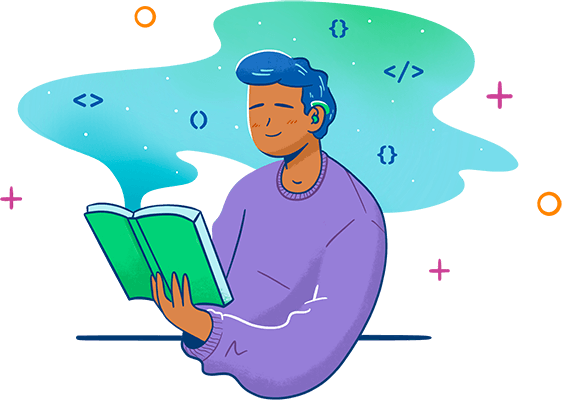Beginning Python
Python is a programming language that is used for a variety of different web applications. In this Beginning Python learning Track, you'll establish the basics of this popular language.
Python is used for web applications, servers, information security, artificial intelligence, data science, mathematics, video games, and even robots. It is commonly used by many Fortune 500 companies and top technology startups. By the end of this Track, you’ll have what it takes to kick off your Python coding journey.
We'll start off this Track with courses in Python Basics, like syntax, numbers, and loops. Then we'll tackle Python lists and Python tuples. Next is our course on Python Functions—you'll learn about Python functions, how to send and receive values to functions, and about Python packing and unpacking.
The next part of the Track will take you through the ins and outs of Python Sequences, Dictionaries, and Dunder Main. These principles are the next building blocks you'll use as you continue to establish your Beginning Python essentials.
To wrap up this Track, we'll cover Object-Oriented Python and tips for writing better Python code. Finally, wrap up your Beginning Python learning with a course on dates and times in Python.
Treehouse is the best place to learn Python, and this Track is a perfect place for anyone to start. Yes, even if you've never coded before! Join us and let's get started.
-
An entry-level salary for the technologies covered in this track is about $70,000 / yr on average.
-
Some companies that use these technologies regularly include: Google, NASA, Nokia, IBM, Digg, Dropbox, Pinterest, Reddit, Yelp, Apple, and Amazon
Ready to start learning?
Treehouse offers a 7 day free trial for new students. Get access to 1000s of hours of content. Learn to code, land your dream job.
Start Your Free Trial
-
Course
- 1
- 2
- 3
- 4
Python Basics
Learn the building blocks of the wonderful general purpose programming language Python.
-
Course
- 1
- 2
- 3
Introducing Lists
Lists are a powerful data type that allows you to store multiple ordered values in a single container. You are gonna love them.
-
Course
- 1
Introducing Tuples
Learn about a Python data structure that's similar to lists but with one key difference!
-
Course
- 1
- 2
- 3
Functions, Packing, and Unpacking
Learn the ins and outs of Python functions, how to send and receive values to functions, and all about Python packing and unpacking.
-
Course
- 1
- 2
Python Sequences
Discover several types of Python sequences, many ways of sequence iterations, and all of the common sequence operations.
-
Course
- 1
- 2
Introducing Dictionaries
Another useful Python data structure is the dictionary. Learn how to write one and use one in your day-to-day Python code.
-
17 minWorkshop
Dunder Main
In this workshop, we’ll talk about using a recommended Python best practice, dunder main to control the execution of our code.
Viewed -
Course
- 1
- 2
- 3
Basic Object-Oriented Python
Learn the powerful object-oriented method of designing and laying out code.
-
1 minInstruction
Practice OOP
Practice basic object-oriented Python concepts to improve and solidify your skills....(continue reading)
Viewed -
Course
- 1
- 2
- 3
- 4
Python Dates and Times
As a Python developer, you will inevitably come across the need to use dates and times in your projects. This course will teach you how to use Python to work with dates and times. You will learn how to manipulate and format dates, calculate time differences, and explore the built-in datetime module. By the end of this course, you will have a solid understanding of how to handle dates and times in Python for a variety of applications. Throughout this course, we'll work together to build a simple app that will utilize this new concept and solidify your understanding.
-
Course
- 1
- 2
Write Better Python
We've learned the ins and outs of Python. We're comfortable making all sorts of data types, writing functions, and creating classes. But now we need to look at how our Python code should be formatted so it matches the standard. We'll also look at how to get our code to give us help() and how we can use logging and pdb to help us keep track of what's going on inside the code.
-
Track Completion
This course includes:
- Python Basics 3 hours
- Introducing Lists 105 min
- Introducing Tuples 13 min
- Functions, Packing, and Unpacking 65 min
- Python Sequences 65 min
- Introducing Dictionaries 36 min
- Dunder Main 17 min
- Basic Object-Oriented Python 2 hours
- Practice OOP 1 min
- Python Dates and Times 2 hours
- Write Better Python 70 min